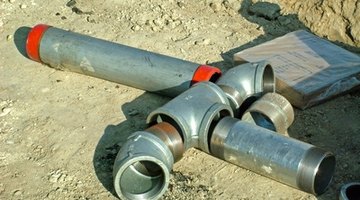How to Tighten Galvanized Pipe
Galvanized piping is a relic from the plumbing past, typically found in older homes. The pipe is made from galvanized steel, which is metal that has been treated with several layers of zinc alloy to prevent corrosion and rust. Although galvanized piping suits a number of uses, it is no longer the best choice for modern indoor plumbing because of its susceptibility to clogging due to inner corrosion. At connection points with fittings and joints, the pipes can become loose and require tightening.

-
Turn off the main water valve.
-
Fit your wrench onto the lock nut that secures the fitting to the loose pipe. Turn the wrench counterclockwise to loosen. Apply a few drops of penetrating lubricant if the fitting is very snug.
-
Remove the pipe from the fitting and wipe away the excess lubricant with a rag.
-
Pour vinegar onto a metal-bristled scrub brush and clean away any corrosion on the pipe and fitting threads if necessary. Wipe the threads clean when finished.
-
Squeeze a fair amount of anaerobic sealant onto the threads and rub it in so that they are completely covered. This type of sealant keeps out air and water and prevents further corrosion. It also creates a tight bond between the pipe and fitting threads. Wear gloves for this step.
-
Thread the fitting back onto the pipe and replace the lock nut. Secure the lock nut as tightly as possible with your pipe wrench.
-
Allow the sealant to set and cure for an hour before turning your main water valve back on.
References
Tips
- Repeat the above steps for any loose fittings or joints in your home plumbing system.
- If you notice that your galvanized steel system is consistently producing weak water pressure, it may be a result of total corrosion. You may wish to contact a professional plumber and inquire about replacing your pipes.
Warnings
- Allow the water to flush out any excess sealant for several minutes before drinking or bathing in it. The chemicals in the sealant are hazardous.
Writer Bio
Brandon Getty began writing professionally in 2008, with columns appearing in "Thrasher" magazine. He received a Bachelor of Arts in literature from the University of California, Santa Cruz, and lives in Stockton, Calif.
Photo Credits
- plumbing fittings image by Greg Pickens from Fotolia.com
More Articles



